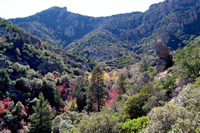Galiuro Mountains
 This view of Bassett Peak, the highest peak in the Galiuro Mountains, shows the mixture of oak, oak-pine, and pine forests that are found at the highest elevations in this mountain range. Photo by Scott Surgent at www.surgent.net.
This view of Bassett Peak, the highest peak in the Galiuro Mountains, shows the mixture of oak, oak-pine, and pine forests that are found at the highest elevations in this mountain range. Photo by Scott Surgent at www.surgent.net.
 Canyons in this mountain range are wet enough to support trees like bigtooth maple, Arizona sycamore, and walnut. Photo by Leonid Kunyansky at math.arizona.edu.
Canyons in this mountain range are wet enough to support trees like bigtooth maple, Arizona sycamore, and walnut. Photo by Leonid Kunyansky at math.arizona.edu.
 Arivaipa Canyon cuts through the northern end of the mountain range. It has a perennial stream that supports several endangered fish. Photo by Charlie McDonald.
Arivaipa Canyon cuts through the northern end of the mountain range. It has a perennial stream that supports several endangered fish. Photo by Charlie McDonald.
 The lush riparian vegetation of Aravaipa Canyon contrasts sharply with the saguaros and other desert plants on the canyon slopes just a few feet above the stream. Photo by Charlie McDonald.
The lush riparian vegetation of Aravaipa Canyon contrasts sharply with the saguaros and other desert plants on the canyon slopes just a few feet above the stream. Photo by Charlie McDonald.
High Point: Bassett Peak, 7,663 feet
Elevation Change from Base: 4,463 feet
Vegetation at Highest Elevations: pine forests
The Galiuro Mountains are a block-fault range consisting of two high parallel ridges separated by two valleys, one sloping to the north and the other to the south. These deeply incised valleys, Rattlesnake and Redfield, run parallel to the lengths of the ridges. Pine forests with elements of mixed-conifer forests including some aspen are the dominant vegetation at higher elevations both in canyons and on north slopes. Slightly lower elevations support woodlands of oak, alligator juniper, and Mexican pinyon. Riparian growth along the watercourses includes Arizona sycamore, alder, ash, bigtooth maple, walnut, and Apache plume.
Special Places:
- Galiuro Wilderness: This wilderness of 76,317 acres has an extensive trail network, many of which follow historic routes established in the late 19th and early 20th centuries. Road access to trailheads is extremely poor requiring travel over many miles of often poorly maintained dirt roads. As a result, this wilderness has low visitation and provides excellent opportunities for wilderness solitude.
- Aravaipa Canyon: This canyon cutting through the northern end of the mountain range is managed by the Bureau of Land Management and The Nature Conservancy as the Aravaipa Canyon Wilderness. A perennial stream runs through the canyon producing a lush riparian corridor only a few feet away from yuccas, cacti, and desert shrubs on the canyon slopes. This is a popular hiking destination that requires a permit obtained in advance from the Bureau of Land Management.
Special Plants:
- Erigeron piscaticus
- Penstemon discolor
- Salvia amissa
- Thelypteris puberula var. sonorensis
Further Reading:
- Aravaipa Canyon Wilderness
- Wilson, J.P. 1977. Guns and gold: History of the Galiuro Wilderness, Coronado National Forest (PDF). USDA Forest Service, Southwestern Region. Albuquerque, New Mexico.


